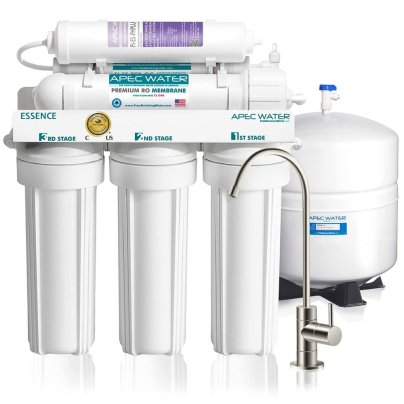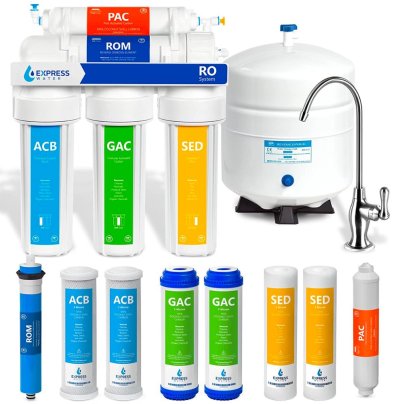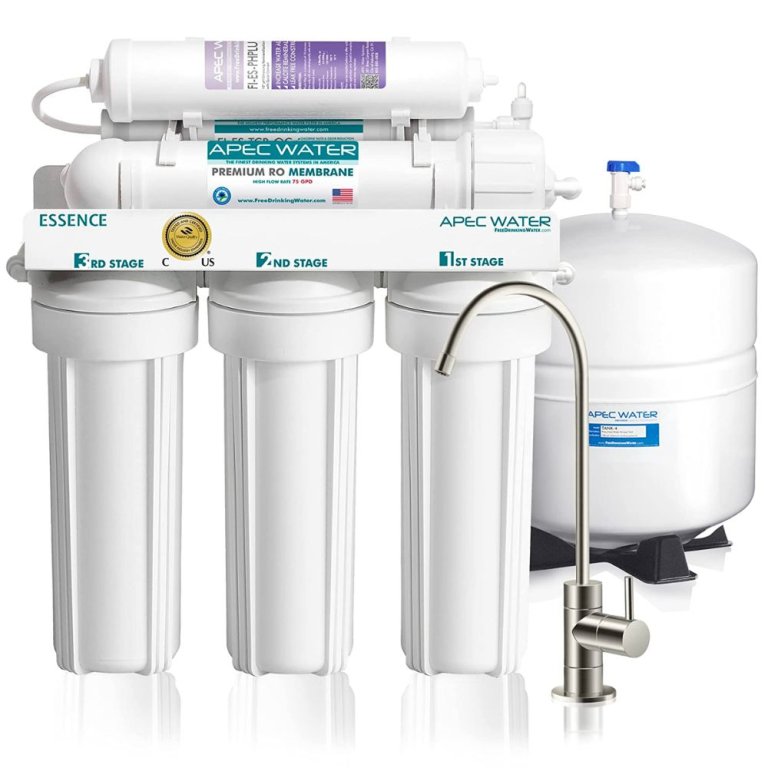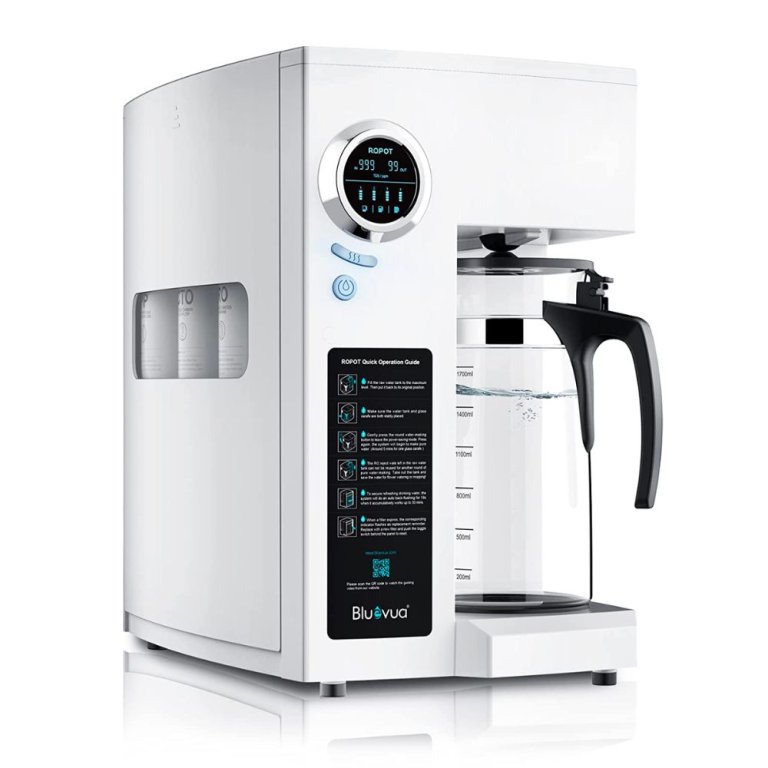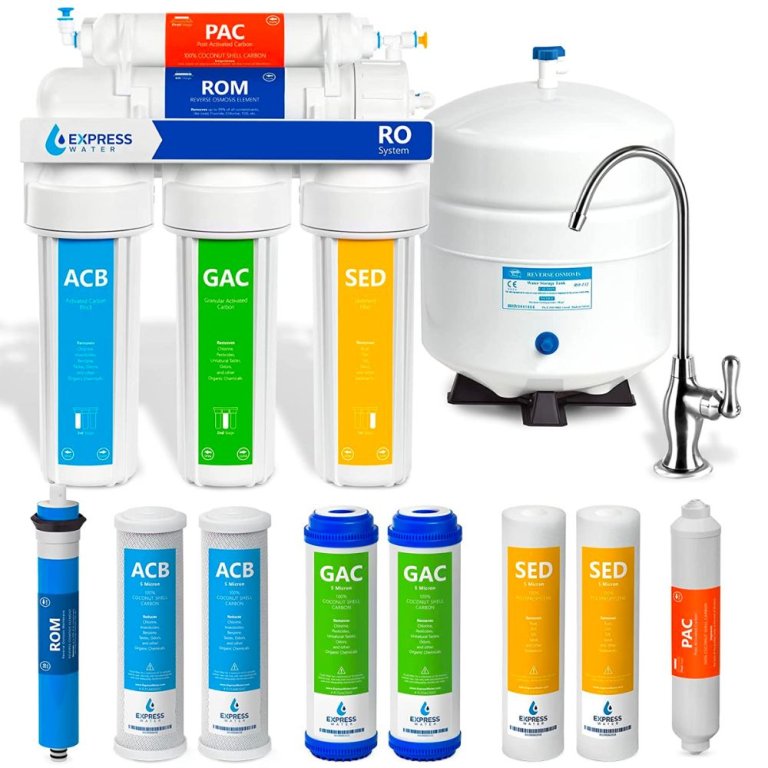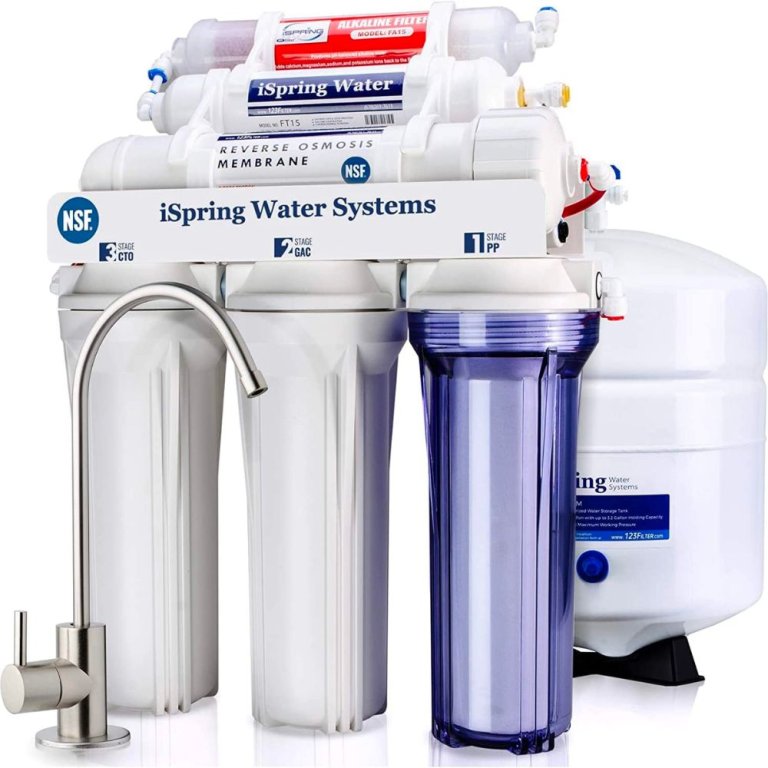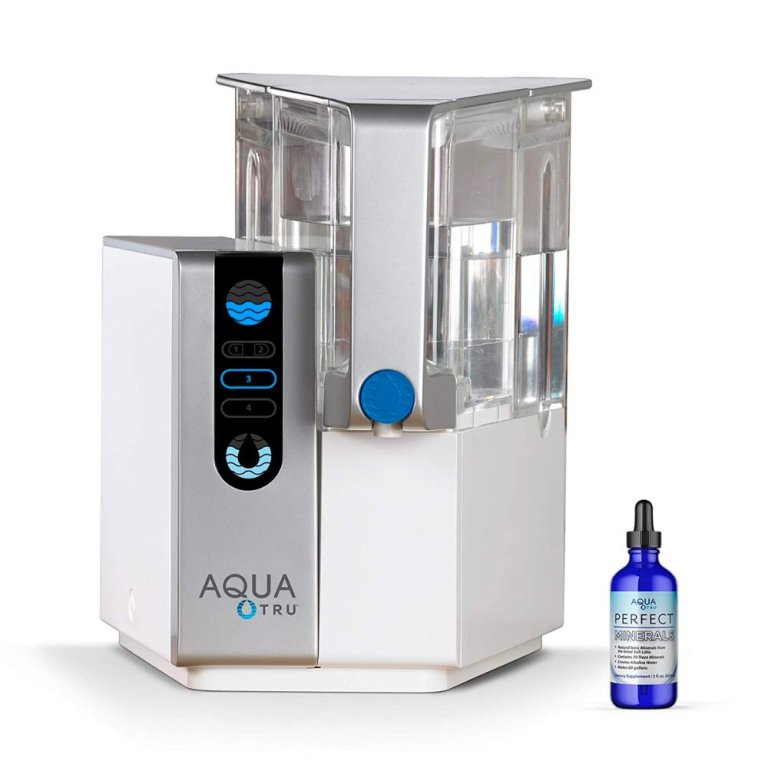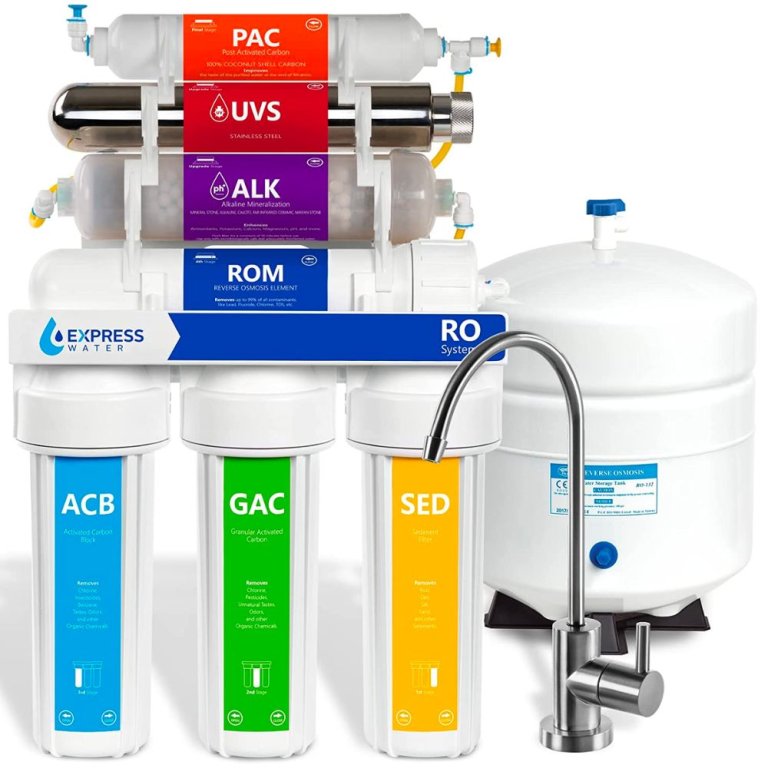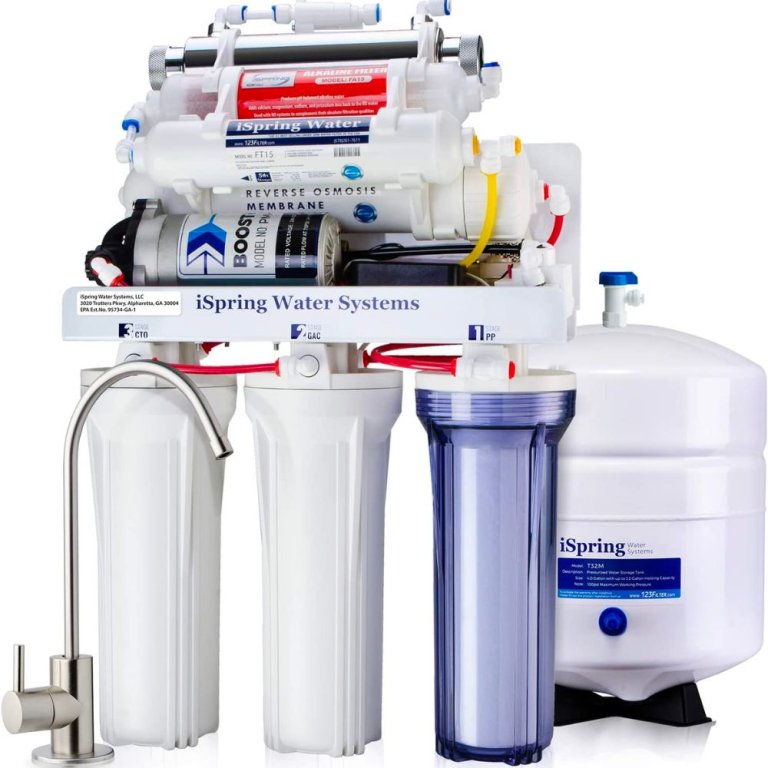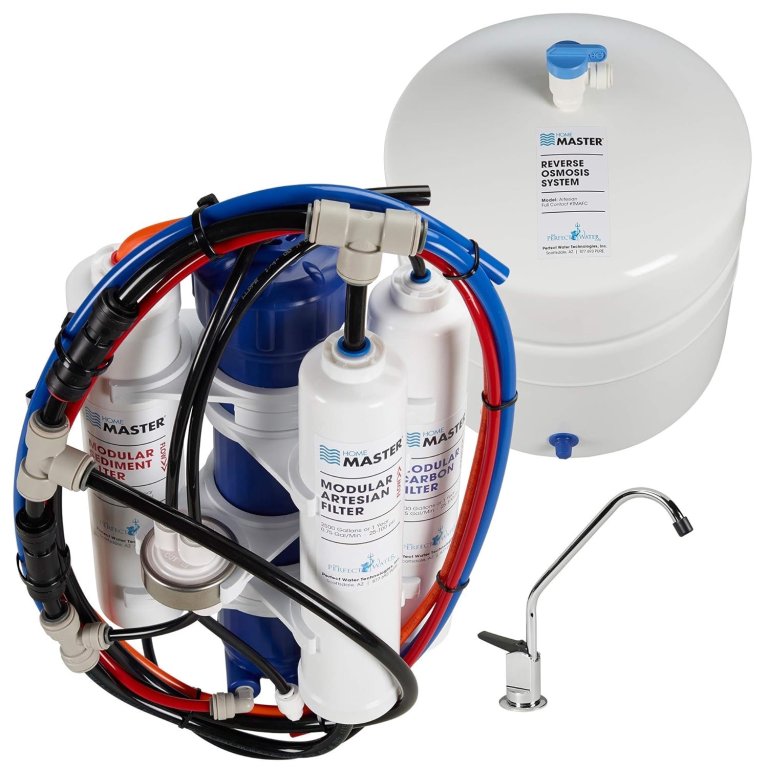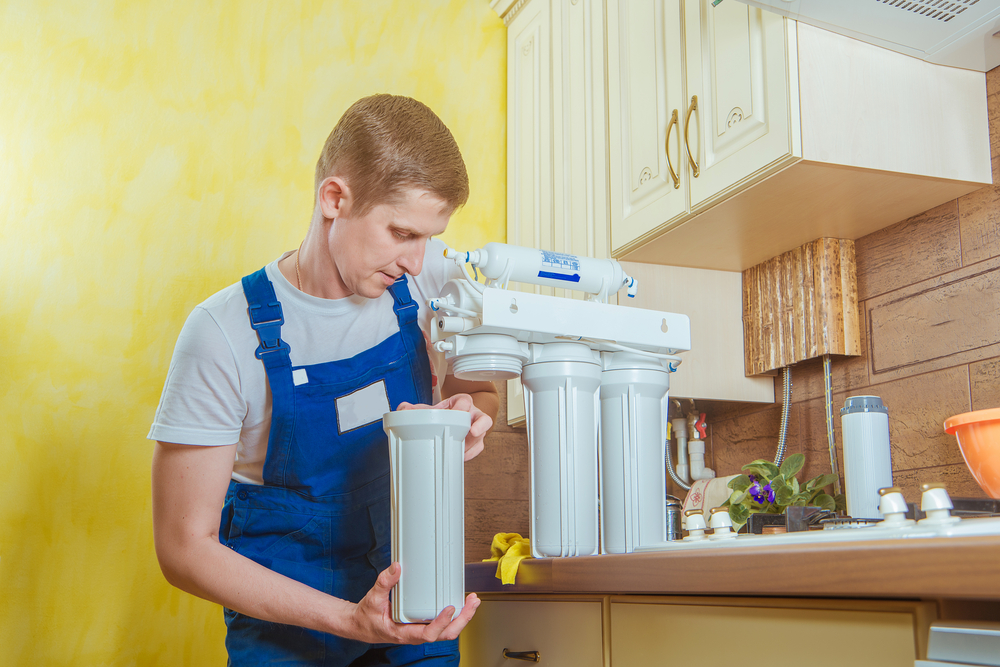
We may earn revenue from the products available on this page and participate in affiliate programs. Learn More ›
To reduce contaminants from drinking water or improve the taste and smell of tap water, water filters in refrigerators and pitchers can do the job. To take water purification to the next level, , however, consider a reverse osmosis water filtration system.
A reverse osmosis (RO) water system integrates with the plumbing under your kitchen sink to force water through a semipermeable membrane and a series of filters, removing sediment and contaminants, providing dozens of gallons of purified water each day.
This article will explore factors you will want to consider when shopping for the best reverse osmosis system and suggests some of our top options. To ensure that our products perform as promised, we also conducted hands-on testing with a few select models.
- BEST OVERALL: Apec Water ROES-PH75 Essence Reverse Osmosis System
- RUNNER-UP: Bluevua RO100ROPOT Countertop Reverse Osmosis System
- BEST BANG FOR THE BUCK: Express Water RO5DX Reverse Osmosis System
- BEST UNDER-SINK: iSpring RCC7AK 6-Stage Reverse Osmosis System
- BEST TANKLESS: Waterdrop G2 Tankless Reverse Osmosis System
- BEST COUNTERTOP: AquaTru Classic Countertop RO Water Purifier
- BEST FOR APARTMENTS: RKIN AlcaPure Zero Installation Purifier Water Filter
- BEST FOR DRINKING WATER: Express Water Alkaline & Ultraviolet RO System
- BEST FOR WELL WATER: iSpring RCC1UP-AK 7-Stage UnderSink RO System
- BEST NSF-CERTIFIED: Home Master TMAFC Full Contact Reverse Osmosis System
- BEST RO ICE-MAKER KIT: Apec Water Icemaker Kit for Apec RO System
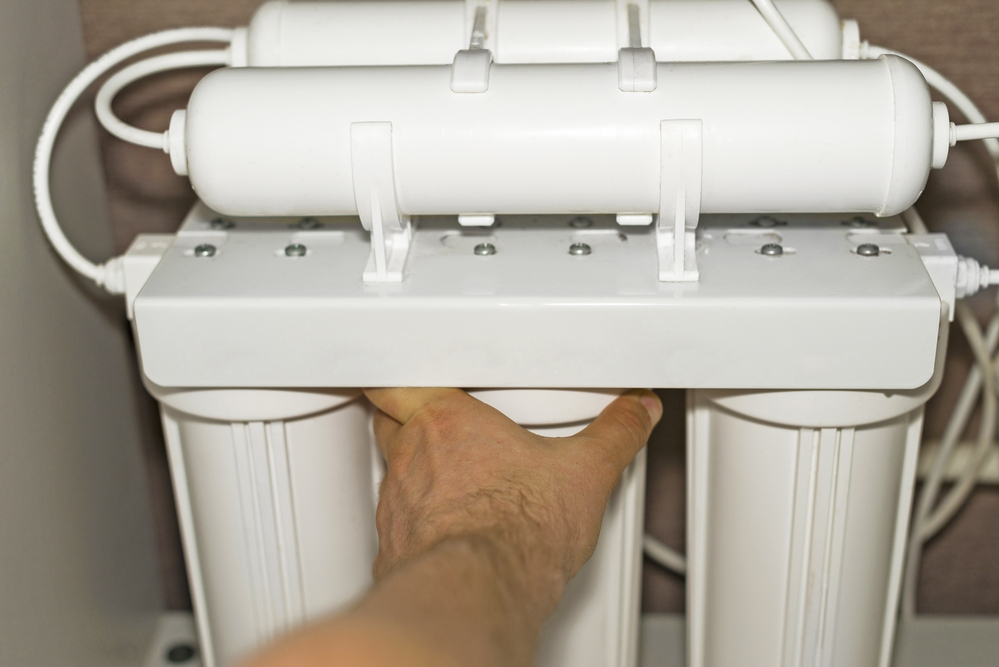
How We Chose the Best Reverse Osmosis Systems
We researched and tested some of the most sought-after reverse osmosis water filter systems in their respective categories and discovered that the best models are determined by their tank size, water output, included filtration stages, filtration type, and other special features included by select brands.
Whether you are looking for a countertop reverse osmosis water filter for a few people or need a large under-sink unit that can support an entire household, the models listed below range from 1- to 400-gallon water outputs per day with their tankless or tanked constructions. Those options that do have tanks can hold ½ gallon to over 4 gallons of water on hand, while tankless options can produce unlimited clear water on demand.
As for the filtration processes, we featured options that include 4 to 11 filtration stages, some of which remove over 99 percent of contaminants, odors, and tastes with alkaline, ultraviolet (UV), and/or deionization systems. We also made sure that our top picks came with National Sanitation Foundation (NSF) certifications for reliability and peace of mind. Some picks are capable of adding healthy minerals and vitamins as they filter, including magnesium and calcium. For added ease of use and effectiveness, select options include LED displays and easy-to-change filters.
Our Top Picks
The products below represent the top standard, countertop, and tankless reverse osmosis water treatment systems from the industry’s leading manufacturers. These units feature high output and efficient wastewater-to-purified-water ratios, our own insights from hands-on testing, and thoroughly vetted pros and cons.
Best Overall
Apec Water ROES-PH75 Essence Reverse Osmosis System
Pros
- High-flow system designed to provide fresh drinking water for busy homes
- Filters last for up to a year removing 99 percent of contaminants and adding beneficial minerals
- Straightforward to install; includes faucet, and is Water Quality Association Gold Seal certified
Cons
- Although complaints are rare, some users feel the filters need changing more often than expected
Product Specs
- Tank size: 4 gallons
- Water output: 75 gallons per day
- Number of filtration stages: 6
With easy installation and high-capacity filters that last much longer than those of other systems, Apec’s RO system is an excellent option for purifying your home’s water. Whereas filters on other systems may last for only a few months, the filters on this six-stage system will last for a full year before needing replacement.
The system’s six stages remove contaminants and 99 percent of bacteria while also adding essential healthy minerals and calcium. This system produces up to 75 gallons of treated water each day. A flow restrictor and automatic shut-off valve keep wastewater production to 3 gallons for every 1 gallon of treated water. This system does use a 15-inch long by 11-inch wide 4-gallon tank, so make sure you have plenty of space under your kitchen sink.
Get the Apec Water ROES-PH75 reverse osmosis system at Amazon, Lowe’s, The Home Depot or Wayfair.
Runner-Up
Bluevua RO100ROPOT Countertop Reverse Osmosis System
Pros
- High-quality, compact, and portable RO system ideal for home, office, or RV use
- 4-stage filter removes contaminants and reduces TDS for improved water taste
- LED display provides precise water-quality information and filter change alerts
Cons
- Competitively priced for a countertop model but still expensive compared to many under-sink units
Product Specs
- Tank size: Pitcher holds 1,700 milliliters (0.45 gallon)
- Water output: 100 gallons per day
- Number of filtration stages: 4
The Bluevua countertop RO system has one major advantage over under-sink models: There is zero installation required. Not only is this convenient, but it’s also ideal for those who want the advantages of reverse osmosis in the office or their RV. It isn’t necessary to buy several units; this model can be unplugged and moved.
The four-stage filtration removes harmful contaminants and reduces total dissolved solids (TDS) to improve the taste of the water. Filters last anywhere from 12 to 24 months and take just a couple of seconds each to change. Unusually, the pitcher is high-quality glass rather than plastic.
Output is impressive at up to 100 gallons per day capacity, though the pitcher only holds 0.45 gallons, so regular refilling would be required in busy environments.
Get the Bluevua reverse osmosis system at Amazon.
Best Bang for the Buck
Express Water RO5DX Reverse Osmosis System
Pros
- An efficient 5-stage system that removes dangerous contaminants at a budget-friendly price
- The easy-to-understand design allows for money-saving DIY installation
- Certified by specialist food-safety organization National Sanitation Foundation (NSF) to American National Standards Institute’s (ANSI) 58 requirements
Cons
- While most units appear trouble-free, a few owners have reported leaks
Product Specs
- Tank size: 4 gallons
- Water output: 50 gallons of water per day
- Number of filtration stages: 5
With its low price tag and 50-gallons-per-day capacity, this RO system from Express Water is an excellent option for shoppers on a budget. This five-stage system includes alkaline, UV, and deionization treatment and removes dangerous contaminants such as lead, arsenic, and chromium. A fifth stage removes taste or odor.
It’s also customizable, with the ability to add additional filtration attachments. Other features include a leak-detection system. The Express Water RO system offers a simplified installation process designed specifically for DIYers. Express Water also has on-demand support from experts who are ready to walk you through the installation process.
Get the Express Water RO5DX reverse osmosis system at Amazon, Lowe’s, The Home Depot or Walmart.
Best Under-Sink
iSpring RCC7AK 6-Stage Reverse Osmosis System
Pros
- An affordable system with an alkaline remineralized filter for healthier, better-tasting water
- Removes lead, arsenic, asbestos, and other contaminants to NSF/ANSI safety standards
- Includes a solid-brass nickel-plated faucet and push-fit connectors for rapid installation
Cons
- Filtration always reduces pressure, but some owners feel this model is more restrictive than necessary
Product Specs
- Tank size: 3.2 gallons
- Water output: 75 gallons per day
- Number of filtration stages: 6
Capacity is often an issue when it comes to under-sink RO systems; a typical customer complaint is that their RO system just doesn’t produce enough water. That’s not the case with this system, which produces up to 75 gallons of purified water each day—more than enough for most households.
And while many RO filter systems stop at five stages, iSpring adds a sixth stage, which includes a remineralization filter that adds healthy minerals removed in the previous stages back into the water. In addition to its capacity and filtration system, owners also love the modern brushed-nickel look for the faucet, which adds both elegance and purified water to a kitchen.
Get the iSpring RCC7AK reverse osmosis system at Amazon, Lowe’s, The Home Depot or Walmart.
Best Tankless
Waterdrop G2 Tankless Reverse Osmosis System
Pros
- Compact tankless system requires less space than typical alternatives and is easy to install
- High filtration combined with very high flow rate and low wastewater ratio
- Requires just 2 filters that are quick and easy to remove and replace
- Excellent longevity; included filters last for either 12 or 24 months
Cons
- Both the main unit and replacement filters come with relatively high price tags
Product Specs
- Tank size: Tankless
- Water output: 400 gallons per day
- Number of filtration stages: 7
Two of the biggest complaints about RO systems are the massive tank that takes up a lot of the space under the kitchen sink and the limitations in purified water capacity. Reclaim that space and multiply your purified water output with this tankless RO system from Waterdrop. This system takes up 70 percent less cabinet real estate while boosting your purified water to a whopping 400 gallons per day.
The Waterdrop also produces faster water flow, filling a cup with filtered water much faster than a standard system. The system includes compact filters that remove multiple contaminants, resulting in a unit that takes up less space. The filter design also means the filters will last much longer than the standard 6 months. When it is time to replace them, removing the filters is an easy twist-and-pull process.
Get the Waterdrop reverse osmosis system at Amazon, Walmart or Waterdrop.
Best Countertop
AquaTru Classic Countertop RO Water Purifier
Pros
- Doesn’t take up any valuable space under the sink and requires no DIY installation
- Patented 4-stage purification technology has been tested to NSF certification standards
- Smart connectivity option with app to monitor water consumption, filter status, etc. (extra cost)
Cons
- It’s expensive and needs regular refilling rather than providing constant water at the faucet
Product Specs
- Tank size: 1 gallon
- Water output: 1 gallon every 12 to 15 minutes
- Number of filtration stages: 4
The AquaTru countertop water filtration system allows for filtered water without taking up space under the cabinet and eliminates the need for DIY installation.
This self-contained system is ready to go out of the box. The four-stage system removes 83 contaminants, including lead, chromium, copper, radium, and chlorine. Its quick-installation twist-and-seal filters last up to 2 years. Fill the gallon tank and wait 12 to 15 minutes for the system to purify the water. And at just 14 inches wide, this system won’t take up much real estate on your counter either.
Get the AquaTru reverse osmosis system at Amazon, The Home Depot, or AquaTru.
Best For Apartments
RKIN AlcaPure Zero Installation Purifier Water Filter
Pros
- A very compact countertop model that’s ideal for apartments or smaller households
- No installation required; uses less electricity than a typical domestic light bulb
- Removable BPA-free tanks are easy to clean with ordinary dish soap
Cons
- Comes with a premium price tag and has a relatively small tank capacity
Product Specs
- Tank size: ½ gallon
- Water output: 75 gallons per day
- Number of filtration stages: 4
Just because you’re living in an apartment doesn’t mean you can’t take advantage of reverse osmosis water purification technology. This plug-and-play countertop water purifier requires no under-sink installation, making it an excellent option for those renting property. With its compact design—it’s just 9.5 inches wide—this water purifier is ideal for smaller residences. When it’s time to move out, simply pack it up and take it with you.
It features a four-stage filtration system that removes up to 99 percent of contaminants. Additional filters add beneficial minerals such as calcium and magnesium, while a post-filter removes tiny traces of impurities. The RKIN AlcaPure purifier produces ½ gallon of purified water in about 15 minutes.
Get the RKIN reverse osmosis system at Amazon or RKIN.
Best For Drinking Water
Express Water Alkaline & Ultraviolet RO System
Pros
- Combines ionically activated minerals and UV sterilization to deliver ultraclear filtered water for drinking
- Claims to provide the highest contaminant reduction of any RO system currently available
- Included faucet is available in 5 different finishes to match individual kitchen decor
Cons
- Filter and UV bulb life is only 6 months, and replacing them is quite expensive
Product Specs
- Tank size: 3.2 gallons
- Water output: 50 to 100 gallons per day
- Number of filtration stages: 11
For high-quality drinking water under your kitchen sink, go with the system that offers the highest level of filtration. When five or even seven stages of filtration simply aren’t enough, there’s Express Water’s 11-stage RO system.
Stages one through four filter out sediments and remove such contaminants as arsenic, chromium, and lead. Stages five through nine add valuable minerals, antioxidants, and oxygen back into your water. The final two stages include an UV sterilizer and a filter that removes odor and taste. What’s left at the other end of this under-sink reverse osmosis system is ultrapure drinking water. Keep in mind that the high amount of filtration this system offers does get costly when it comes time to replace the filters.
Get the Express Water alkaline and UV reverse osmosis system at Amazon, Lowe’s, The Home Depot or Walmart.
Best for Well Water
iSpring RCC1UP-AK 7-Stage UnderSink RO System
Pros
- Provides effective filtration and UV light to kill bacteria commonly found in well water
- Booster pump ensures good flow rate and low waste, regardless of household water flow pressure
- Includes high-quality, quick-connect brass faucet with long-life ceramic valve
Cons
- Demands a considerable investment and requires plenty of space under the sink
Product Specs
- Tank size: 2.5 gallons
- Water output: 100 gallons per day
- Number of filtration stages: 7
Because well water comes directly from the ground, it can sometimes require a significant amount of processing to filter out impurities and make the water palatable for drinking. With its seven-stage system, iSpring offers maximum filtration. In addition to removing harmful pollutants, this system includes an alkaline remineralization filter that restores healthy minerals while providing an alkaline balance that improves taste.
The system includes a crucial UV stage, which effectively removes harmful bacteria and is a must-have for those on well water. Customers say they love the taste of the water produced by this filtration system. The iSpring features a 2.5-gallon storage tank for a 100-gallon-per-day capacity, producing plenty of drinking water for a household.
Get the iSpring RCC1UP-AK reverse osmosis system at Amazon, Lowe’s, or The Home Depot.
Best NSF-Certified
Home Master TMAFC Full Contact Reverse Osmosis System
Pros
- The manufacturer’s entire line of products comes with an NSF certification for reliability and peace of mind
- Fast Flo RO! Kit included for faster flow rate; easy to install without the use of wrenches
- Comes with a patented mineralization system, catalytic carbon, and sediment filters; catches contaminants as small as 0.0001 microns
- Purification system, tank, adapter, faucet, and drain saddle included with purchase
Cons
- Some users have reported difficulties with installing the unit or with slight leakage while in use
Product Specs
- Tank size: 3.2 gallons
- Water output: 75 gallons per day
- Number of filtration stages: 7
Though all of the reverse osmosis systems on this list are reliable when it comes to removing contaminants and providing clean water, the sight of an NSF certification provides that extra peace of mind. This under-sink reverse osmosis system from Home Master comes with this certification, as do all of the other models from the brand. It comes with a patented mineralization system that adds magnesium and calcium twice throughout the filtration process for clean-tasting water and protection against tank degradation.
Included with this system are the purification unit, the filters, the tank, a ⅜-inch adapter with a shut-off valve, a chrome faucet, and a drain saddle, all of which are easy to install wrench-free. The purification unit measures just 16 inches high by 8 inches wide and the tank is 15 inches high by 11 inches in diameter, both of which are compact enough to fit under most sinks without taking up too much room.
This Home Master TMAFC under-sink reverse osmosis system also comes with a Fast Flo RO! Kit with larger fittings and tubing, which allows for a faster flow rate to provide over 75 gallons per day. The lifespan of the filters lasts up to 2,000 gallons before requiring any replacements. This Home Master has seven stages of filtration with catalytic carbon and sediment filters included that are capable of filtering contaminants, chemicals, and chlorine of up to 0.0001 microns in size, providing excellent-tasting clean water.
What our tester says: Glenda Taylor, Bob Vila staff writer and product tester, notes the following about this reverse osmosis system: “I’m a stickler for good-tasting water and crystal-clear ice tea. After several years of renting an RO unit from a national water specialist, we installed the Home Master TMAFC Full Contact reverse osmosis system. It has a fast fill rate so there’s always clean water for drinking and cooking. We liked the TMAFC so much, we bought a second unit for the sink in our master suite.”
Get the Home Master reverse osmosis system at Amazon, Lowe’s, or The Home Depot.
Best RO Ice-Maker Kit
Apec Water Icemaker Kit for Apec RO System
Pros
- Connects Apec and many other RO systems to refrigerator ice makers
- Delivers higher standards of purification than standard fridge filters for healthier ice cubes
- Easy to fit, including shut-off ball valve and 20 feet of ¼-inch tubing
Cons
- Care is needed with the push-fit connectors to avoid leaks
Product Specs
- Tank size: No tank included
- Water output: Compatible with most Apec filtration systems
- Number of filtration stages: Compatible with most Apec filtration systems
What good is purified water if you can drink only lukewarm glasses of it? One solution is to start filling ice-cube trays. A better solution is to connect your RO system to your refrigerator’s ice maker with this kit, which allows you to create pure ice cubes to go with the purified water from your RO system.
This kit will work with most water filter systems using ¼-inch tubing. It includes 20 feet of ¼-inch tubing and two quick-connect fittings for making the connection to your fridge. Make sure you have an easy way to run this line from your RO system to your fridge to ensure a seamless installation.
Get the Apec Water ice maker kit for reverse osmosis systems at Amazon, Lowe’s orThe Home Depot.
Jump to Our Top Picks
What to Consider When Choosing a Reverse Osmosis System
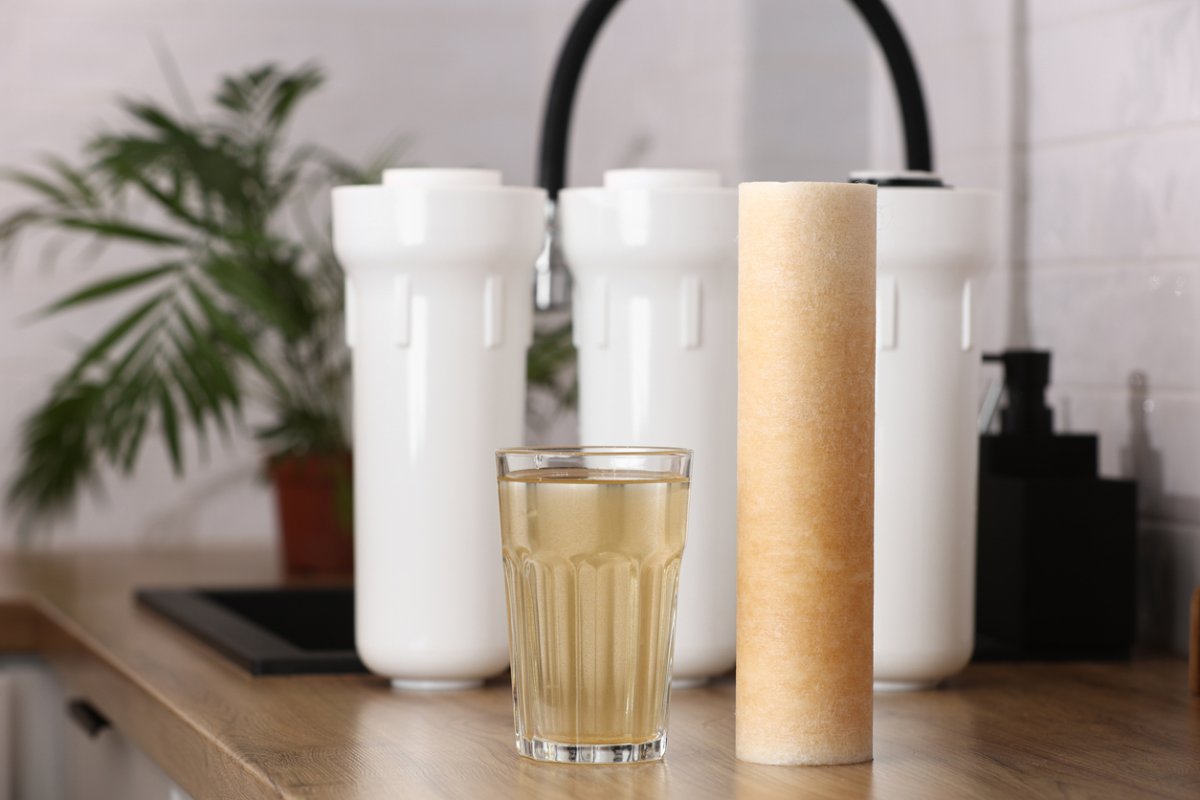
There are a number of factors to consider when shopping for a reverse osmosis system, including whether you need to filter tap or well water, your plumbing requirements, desired water output, the number of filtering stages, and installation demands.
Plumbing Requirements
Before purchasing a reverse osmosis system, it’s essential to consider a few plumbing factors. Start by checking out the space under your kitchen sink. Because it uses multiple filters and a large storage tank, a reverse osmosis system takes up a lot of real estate. That means items stored under your sink will have to go. And if you have a garbage disposal, it may be challenging to fit a reverse osmosis system below the sink.
You’ll also need to assess the top of your sink. RO systems require a separate faucet, which typically sits adjacent to your standard kitchen faucet. This means you’ll need to install a second faucet at your sink either by drilling through the sink edge or the countertop.
RO systems also use a dedicated air-gap or nonair-gap faucet. Reverse osmosis systems remove impurities by separating them from a water supply in liquid form. That liquid then must be discharged through an air gap that drips gallons of wastewater into an outlet tube connected to the sink drain.
An air-gap faucet prevents the contaminated water from being drawn back into the RO system’s discharge side. If the faucet is not near the RO system and is therefore not sharing a discharge line, there is no need for an air-gap faucet. Otherwise, purchase a system with an air-gap faucet.
Water Output
Even though an RO faucet will dispense water quickly, it refills the storage tank at the relatively slow rate of about 50 gallons per day. That translates into a water output of about 1 gallon every 30 minutes. With that in mind, you need to be selective about when to use water from the RO tap.
Only use the RO faucet for drinking and cooking water. For a household with a lot of pure-water needs, consider purchasing a high-output system, which can produce up to 90 gallons of treated water per day, or a tankless system, which can provide up to 400 gallons of purified water.
Wastewater
One criticism of reverse osmosis water filtration systems is that they create a lot of wastewater. Unlike standard filters, which remove solid contaminants as the water passes through the filter, reverse osmosis filters remove those contaminants in liquid form, creating wastewater called brine. A conventional RO system can produce a staggering amount of brine—between 3 and 25 gallons per 1 gallon of purified water. With this in mind, look for RO systems that have a low ratio of wastewater to purified water.
Tank Size
RO storage tanks range in size from 3 gallons to 14 gallons; however, tank size can be a bit deceiving when it comes to reverse osmosis systems. The actual storage tank capacity will be less than what the tank is rated to hold. This is because RO storage tanks contain a metal bladder and a bubble of air to create enough pressure to push the water through the faucet when the tap is open.
The actual amount of water the tank will hold varies depending on the amount of air pressure inside the tank. For example, a 4.5-gallon storage tank will hold around 2 to 3 gallons of water. This is important to consider as you shop for an RO tank system that will meet your household’s daily drinking water demands.
Filtering Stages
Because there is no single type of filter that can remove all contaminants by itself, the best reverse osmosis systems feature a series of different filters called stages. While water quality experts generally agree that four stages are enough to purify water, some systems have seven stages or more.
The filtering stages consist of a carbon filter that removes sediment; a reverse osmosis membrane removes dissolved substances from the water; a filter that removes harmful contaminants, microorganisms, and bacteria; and a post filter that removes odor and taste from the water.
Additional filters remove smaller 1-micron particles and excessive amounts of minerals like iron, lead, salt, and nitrates. Larger six- and seven-stage systems include filters that may add valuable minerals to the water lost in previous filtrations, such as calcium, and filters that improve taste and appearance.
High-Pressure Pump
For an RO system to work, it needs water pressure of at least 50 pounds per square inch (psi). Most homes have water pressure between 30 and 80 psi. This high pressure is needed to push the water through the various reverse osmosis filters and still maintain adequate pressure at the tap.
For homes that lack high pressure, an RO booster pump increases the water pressure at the system to up to 80 psi. Even homes that operate on standard city water pressure of 60 psi can benefit from a pump, as an RO system will run better at 80 psi or higher.
Valves
Water enters the system by passing through an RO membrane and then into the tank. RO systems have a shut-off valve, which is a one-way valve that prevents water in the storage tank from backflowing into the membrane when the tank is full.
Once the tank is full, this spring-operated valve engages, stopping the flow of water back against the reverse osmosis membrane, effectively holding it in the tank. The valve automatically reopens when the tank’s pressure drops enough to allow water to enter the RO system again. Though tiny and inexpensive, this valve is crucial to the proper functioning of the RO system.
Ease of Installation
Ease of installation will depend on the reverse osmosis system chosen, and it’s always important to follow the maker’s instructions carefully. There are often online videos available that can provide invaluable help.
Countertop models are the simplest as these don’t require any plumbing. Just plug the unit in, fit the required filters, fill, and wait for the water to pass through. The disadvantage of course is that someone has to remember to refill the tank from time to time.
Under-sink reverse osmosis systems have the advantage of providing water on demand. To do this, they need a cold water feed, and they also need a connection to the drain for wastewater. Both of these will normally be easily accessible from under the sink. While you could call a plumber, fitting an RO system is not a difficult process. Most manufacturers suggest that a competent DIYer could complete the job in around 2 hours, and many homeowners will already possess the basic tools required. Finally, the filters need to be attached, though these usually have simple twist connectors.
The Advantages of Owning a Reverse Osmosis System
Reverse osmosis water treatment systems offer a bevy of health benefits that make them a worthy investment for your home. The filtration process removes bacteria and microorganisms and impurities, such as arsenic, chromium, and other chemical contaminants.
In addition to making healthier drinking water, RO systems also make drinking water tastier. The contaminants in water can cause bitter tastes and foul smells. When RO systems remove these contaminants, the water smells and tastes cleaner.
Although it may not seem this way when you make the initial investment in an RO system, it can save you money. Purchasing bottled water from a grocery store is considerably more expensive than filtering your own water.
And while there is some debate about the impact of RO systems on the environment due to the amount of wastewater produced, they do the environment a favor by reducing the creation of plastic waste that comes from bottled water.
- RO filtration systems offer health benefits by removing impurities, bacteria, and microorganisms from drinking water.
- They improve the taste of drinking water.
- They save money by eliminating the need for bottled water purchases.
- They help the environment by reducing plastic bottle waste.
How to Install a Reverse Osmosis System by Yourself
Save yourself a steep plumber’s bill and read on to learn how to install a reverse osmosis water filtration system yourself.
- Shut off the cold water shut-off valve. Turn the shut-off valve clockwise to shut off the water.
- Open the faucet. This will empty the water left in the lines, minimizing leakage when you disconnect the sink’s supply valve.
- Disconnect the water line from the shut-off valve. Use a pair of pliers to unscrew and detach the supply line. Have a towel or cup handy to catch residual water in the lines.
- Connect the cold water line to the RO system. Using the adapter provided by the RO system, connect the cold water supply line to your system.
- Turn on the cold water supply valve.
- Install the filter and tank. Position the filter and tank under the sink.
- Install the drain line. Locate the system’s drain line. Drill a hole in the sink’s existing waste line, and install the waste line so your system can drain its wastewater here.
- Install the new faucet. If your sink has a predrilled hole, use this to install the new faucet. Otherwise, you’ll need to drill a new hole in the sink or countertop to mount the new faucet.
- Install the new faucet. Once the faucet is installed, the supply line attaches to the output of the RO system.
- Connect the reservoir tank to the filter system. Follow the manufacturer’s instructions to make a proper connection.
FAQs
Osmosis is the process of passing water molecules through a semipermeable membrane from a less-concentrated solution into a more concentrated solution. RO water filtration systems work by passing water through a semipermeable membrane under pressure. The reverse osmosis membrane allows water molecules to pass through but does not allow larger molecules such as bacteria, viruses, urea sodium, and chlorine to pass through.
Reverse osmosis water filtration systems remove harmful bacteria, viruses, sediment, dirt, and a long list of toxic chemicals and compounds, including arsenic, copper, radium, cadmium, and lead.
Because the distillation system cannot altogether remove every trace of chlorine and certain pesticides and herbicides from water, RO filtration systems are more effective at purifying water.
The difference between a single-pass and double-pass RO system is that the water produced from the first pass feeds back through the system again as the feed water for the second pass. This means the water goes through the system twice, creating a higher quality of purified water.
Because RO systems do waste a considerable amount of water, they impact the environment. The average RO filtration system produces about 4 gallons of wastewater per gallon of purified water. That said, RO systems reduce the consumption of bottled water, which is considerably more damaging to the environment due to the use of nonbiodegradable plastic bottles.
